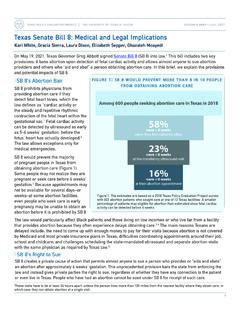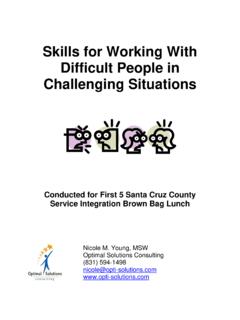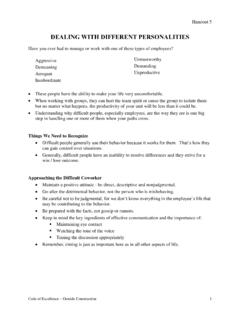Transcription of Dealing With Difficult People - University of Texas …
1 Dealing with Difficult PeoplePRESENTED BY:JEFF STELLMACH, LCSWSENIOR SOCIAL WORKERTHE University OF Texas AT AUSTIN EMPLOYEE ASSISTANCE PROGRAM (EAP)HealthPointEmployee Assistance Program (EAP) EAP is a resource for all benefits-eligible employees, adult dependents or partners, and retirees. Confidential, short-term counseling Community referrals Manager consultation and training Trainings and groups on a variety of topics Workplace safety and crisis management Work/life balance programs (LifeCare) PRC appointments Stress Reduction and Biofeedback Center2 Overview Shifting focus from Difficult People to Difficult behaviors Response strategies and effective statements Assertive communication principles Responding to an angry person Managing your own reaction Individuals in crisis and outside resources Responding to a micro-managing supervisor Responding to a passive/aggressive co-worker Questions and comments3 Who are Difficult People ?
2 Demanding, agitated People People who say offensive things Supervisors who micro-manage Team members who aren t team players Supervisors who dismiss your input Co-workers who communicate in a passive/aggressive style People who monopolize discussionsIn short, Difficult People present us with Difficult are Difficult behaviors? Behaviors that disrupt the task at hand Outside of our normal expectations for the situation Negative for both the person with the behavior and the person having to respond5 Empathy is .. the power of understanding and the ability to imaginatively enter into another person's feelings.
3 Recognition, appreciation, responsiveness, and comprehension. a basic condition that is needed to establish rapport and effective to Difficult People Provide the person an opportunity to express concerns. Validate the importance of his/her concerns. Reflect back to the person that you have heard what they are saying. Set clear expectations and limits for how you will discuss the issue. Initiate statements I hear that this is important to you. What can I do to help? I can see that you take this very seriously and would like help Dealing with the issue. I hear you If I m hearing you correctly, you would like assistance What options do you identify for Dealing with this?
4 I think that the best way I can help you is 8 Using I statements to respond assertivelyI notice that (OR)I hear you saying _____(observable details about the other person s behavior)I feel (OR) think _____(your own thoughts or emotions resulting from the behavior)When you _____(the action or behavior in summary)I m asking you to (OR)I expect that you will _____(your assertion of the behavior you expect from the person)9An angry customerA customer walks in to your reception area. There are several customers already waiting to be served. He walks around the other customers and comes directly to your desk until he is about 4 feet away, inside your personal comfort area.
5 In a loud tone of voice, he demands to be seen immediately. He says, You re just going to tell me to wait my turn like everyone else. How are you feeling at this point? How would you address the customer assertively?10 Validating concern and initiating problem-solvingI hear that this is important to you and that you would like immediate assistance. I am responsible for responding to customers in the order they arrived. I ll be glad to assist you if you ll please wait for your turn to speak with escalatesAs soon as you ve finished speaking, the customer takes another step towards you. He points at you and speaks in a louder voice.
6 He says, Nobody tells me to wait. How are you feeling at this point? How would you address the customer assertively?12 Assertive, limit-setting responsesI noticethat your voice is raised, and you re standing close to me. I feeluncomfortable/threatened when youare communicating like this. I m asking you to speak to me in a calm noticethat your voice is raised, and you re standing close to me. I feel/thinkthat we can t make progress on your concern when youare communicating like this. I m asking you tospeak to me in a calm manner so we can work this out our example When the customer escalated, would you have asked for assistance Dealing with this client?
7 If not, what developments would indicate a need for help? Who would you go to for assistance? Are there any physical factors (body space, relaxation breathing, tone of voice, etc.) that would be important for you to manage in your own response?14 Fight or flight We respond to stressors by increasing heart rate and breathing, directing blood to the limbs and muscles, and scanning the environment for possible threats. We are designed to rapidly respond to stress and challenge, it is adaptive. We are not physically designed to stay in an extended stress response. When fight or flight remains activated, we tend to view all things through the lens of a threat.
8 If we maintain a hyper-focus on a perceived threat, we lose the ability to see other coping options. 15 What to do DO take a deep breath. DO speak slowly and calmly. DO be reassuring yet not to do DON T make sudden movements or physical contact. DON T respond defensively. DON T minimize the person s immediate assistance Immediately report threatening behavior or violence to the University Police Department at 911. Focus on severity, not whether they identify a specific target. Trust your instincts -err on the side of resources Employee Assistance Program (EAP) at 471-3366 for faculty and staff Counseling and Mental Health Center (CMHC) at 471-3515 for students Behavior Concerns Advice Line (BCAL) at 232-5050 when uncertain who to call or needing general advice19 Dealing with a micro-managerYou have a new supervisor who was promoted from within the department.
9 During his first meeting with you, he explains that he wants more accountability from everyone. Since there have been problems with some employees taking long lunch breaks, he is asking everyone to e-mail him when they get back from lunch. In this e-mail he also expects that workers will inform him what they re working on that afternoon. How would you respond assertively to these requests?20An assertive responseI can hear that productivity and punctuality are important to you. I value having autonomy in completing my tasks and feel that I m most productive that way. I m confident that I can keep you updated without having to send an e-mail every afternoon.
10 Can I update you less frequently with the understanding that we can re-assess if that s not working? 21A passive/aggressive co-workerYou have just come out of a weekly staff meeting that involved several co-workers and your supervisor. You are leading a new project which will begin in 2 weeks, and you led a group discussion in the meeting in which you clarified the various project tasks and the staff member responsible for each. Right after the meeting you receive an e-mail from a co-worker in which she writes, That s the first time anyone has told me that I would be doing that task. I was already told that the project manager would be doing that job.















